You are a project manager for Levin Batteries a company that
You are a project manager for Levin Batteries, a company that is considering expanding from their US market to Europe. In order to receive local government tax credits and subsidies, Levin will use only union labor and build their plant in Ireland, Poland or Turkey. Compare the union labor rules and practices in these three countries and make a recommendation as to which location would best serve the needs of your company.
Paper 2-3 pages in length, APA style guidelines, correct spelling, grammar and punctuation
Solution
Labour Regulation-Ireland
Irish labour law has developed according to a British-style voluntarist model. The most important of these are:
Unlimited and fixed-term contracts of employment
Special contracts of employment
The term office-holder has now fallen into disuse, and civil servants are almost exclusively viewed as employees. Only Government Ministers, and those appointed directly by the Minister, might now be seen as office-holders. However the principles of natural justice and fair procedures developed in the courts in litigation involving dismissal of office-holders have now been applied generally, and continue to be applied, by the Employment Appeal Tribunal in any cases involving dismissal of employees.
Probation
Most contracts of employment specify a probation period of twelve months. The Unfair Dismissals Acts do not apply until an employee has worked for twelve months, so during the probation period the employee may be dismissed at will subject to rules on fair procedures and wrongful dismissal.
ted by the Parental Leave Act 1998, which came into effect on December 3, 1998.
Each parent is entitled to 14 weeks parental leave in respect of each child born or adopted on or after 3 June (now 3 December 1993).
The leave must be taken in order to take care of the child, and any abuse of this can lead to the leave being terminated.
Parental leave is not transferable between parents.
The 14 weeks may be taken as a continuous block or, by agreement with the employer, in separate blocks or by working reduced hours.
Parental leave is unpaid but time spent on leave is reckonable for all employment rights purposes other than superannuation.
Employers may postpone parental leave for up to six months in certain circumstances.
Three days force majeure leave may be taken in any one year for a family crisis where the employee’s presence is indispensable.
Not more than five days of force majeure leave may be taken in any three year period.
Employers may give leave in a manner more favourable to employees than the minimum required under the Act.
Disputes under the Act may be referred to a Rights Commissioner.
Section 6 provides the basic entitlement to parental leave. It states that an employee who is the natural or adoptive parent of a child is entitled to 14 working weeks leave to enable him or her to take care of the child. The bill had only made provision for parental leave “without pay”, but this last phrase was deleted during the Dail debates as it was suggested that those words could have prevented local agreements on parental leave with pay. Thus, the entitlement carries no right to pay, but the Act does not prohibit the granting of paid leave by individual organisations.
In the Act, the entitlement to leave originally only applied in respect of children born on or after June 3, 1996 (or whose adoption order was made on/after that date), but the leave could be taken until the child reached the age of 5 years (or where a child has been adopted between the ages of 3 and 8, within two years of making the adoption order). However, following a recent amendment to the Act, eligibility for parental leave is now expanded to include children born or adopted between December 3, 1993 and June 2, 1996. All leave in respect of children born or adopted during this period must be taken by December 31, 2001.
An employee must have worked for at least one year with the same employer before being able to take such leave, and is entitled to parental leave in respect of each child of which he or she is the natural or adoptive parent. This entitlement is non-transferable; it attaches separately to each parent.
Section 7 provides that the leave may consist of a continuous period of 14 weeks, or with the agreement of the employer, a number of periods broken down either into days or hours or a combination of both. This means that the general entitlement is to have one unbroken period of leave. In other words, it may only be broken into smaller periods at the option of the employer. The section also provides that where an employee is entitled to parental leave in respect of more than one child, and the children concerned are not children of a multiple birth, the period of parental leave taken by that parent in any one period of 12 months must not without the employer’s consent exceed the 14 weeks. This means that parents of twins or triplets or other multiple births may take 14 weeks in respect of each child, even if this amounts to more than 14 weeks in one 12 month period. This exception for multiple births was added during the Dail debates on the bill. Section 7 also describes how the leave is to be calculated; if it is done by hourly calculations, the number of hours is calculated according to the number of hours during which the employee worked in the continuous 14 week period just before the commencement of the leave. The employee is entitled to 14 weeks leave, exclusive of holidays, or time spent on maternity leave, adoptive leave or sick leave.
nce the foundation of the State, with the exception of the limited period 1941-46 and certain temporary legislation with respect to the banks in 1973, 1975 and 1976, trade unions and employers have been free to bargain over wages and other conditions of employment without the intervention of the law.
Structure and levels of collective bargaining
Although collective bargaining has been based traditionally on the British voluntarist model and has not been subject to legal regulation (see above), a major feature of Irish industrial relations is the system of centralised wage bargaining which first began in 1948 with the first of a series of wage rounds. Between 1970-82, wage trends were determined by successive National Wage Agreements, which became National Understandings for Economic and Social Development, and have since become the more formalised Social Partnership Agreements (the present one is the PPF, or Programme for Prosperity and Fairness).
These Agreements or Programmes are negotiated at a national level, but local agreements may still be reached, and this is generally done informally. At present, local collective agreements are not binding due to the policy of voluntarism or exclusion of the courts, which is central to collective bargaining and industrial relations practice in Ireland. Whereas it is possible for collective agreements to be registered with the Labour Court, they seldom are in practice. If it is desired, then the parties to a Collective Agreement may apply to the Labour Court to register the Agreement. Once the Agreement is registered and any subsequent amendments notified, the Agreement is legally enforceable.
The parties to collective bargaining
Negotiation procedures
These are informal, and are not regulated by law. However, the Organisation of Working Time Act 1997 gives a more formalised role for collective agreements, allowing flexibility to be reached in the application of the Act through the negotiation of collective agreements. For example, the normal reference period over which the maximum 48-hour working week is calculated is 6 months, but this can instead be calculated over 12 months, where an employer concludes a collective agreement with the workforce, which is approved and registered by the Labour Court under section 24 of the Act. Collective agreements also allow greater flexibility in the scheduling of daily and weekly rest breaks, and the management of night work.
The Act thus gives greater importance to collective agreements, but technically speaking, collective agreements do not provide a way around the Act. Instead, they may provide for more flexibility within the operation of the Act. Section 2(1) defines collective agreement. \"an agreement by or on behalf of an employer on the one hand, and by or on behalf of a body or bodies representative of the employees to whom the agreement relates on the other hand.\"
Thus, they do not have to be union-employer agreements. They may be concluded between an employer and an internal staff association. The procedure for concluding ‘flexibility’ collective agreements is provided for under section 24 of the Act, as follows:
Effects of collective agreements
Collective agreements are generally not binding on the parties. The terms of an agreement may, however, be binding on the workers and employers included within the agreement\'s scope but only to the extent that they are deemed to have been \'incorporated\' into the employees\' individual contracts of employment.
Where an agreement is concluded in a workplace, it will usually be applied to all employees in the organisation whether they are union members or not. The legality of this informal arrangement has, however, not been tested in the courts.
Duration of agreements varies.
Workers\' representation in the enterprise
Representation of workers is either organised through trade unions, or organised on an informal basis, or not organised at all. Until EU legislation comes into effect, there is no obligation on the employer to have a mechanism for the representation of workers in Irish law.
Strikes and lock outs
The legal framework for strike action is made up by a combination of law, collective agreements and case law or a combination. The Industrial Relations Act 1990 is now the governing statute in this area, and has been in force since July 1990. The objective of the Act was to reform the law in relation to trade disputes and Industrial Relation Institutions - to create a better framework/climate for dispute resolution and to incorporate some amendments in relation to trade union Law.
Prior to the 1990 Act, the right to strike and the law pursuant to Trade disputes was enshrined in the Trade Disputes Act 1906. This Act granted certain legal immunities to persons engaged in a lawful trade dispute. These immunities are, to a large extent, preserved in the 1990 Act - the changes are designed to place observance of certain procedures as a precondition before the legal immunities will apply.
The Act defines \"industrial action\" as \"any action which affects, or is likely to affect, the terms or conditions, whether express or implied, of a contract and which is taken by any number or body of workers acting in combination or under a common understanding as a means of compelling their employer, or to aid other workersin compelling their employer, to accept or not to accept terms or conditions of or affecting employment\".
\"Strike\" is defined as meaning \"a cessation of work by any number or body of workers acting in combination or a concerted refusal or a refusal under a common understanding of any number of workers to continue to work for their employer done as a means of compelling their employer, or to aid other workers in compelling their employer, to accept or not to accept terms or conditions of or affecting employment.\"
Section10 of the 1990 Act confers immunity from prosecution or civil action for conspiracy where workers are taking industrial action in \"contemplation of furtherance\" of a trade dispute. Section11 deals with immunity in relation to picketing including secondary picketing and provides that it shall be lawful to engage in peaceful picketing at that employees place of work if the picketing is in contemplation or furtherance of a trade dispute and designed to peacefully obtain or communicate information or to peacefully persuade persons from abstaining from working.
With regard to secondary picketing (picketing at place of work of an employer who is not a party to the dispute) this is lawful only if those picketing have reasonable grounds to believe that the employer whose place of work is being picketed has or is directly assisting their own employer with a view to frustrating the strike or industrial action.
Section12 provides immunity to persons acting in contemplation or furtherance of a trade dispute in relation to actions for breach of contract of employment, inducement to others to breach their contact or a threat to breach the contract of employment (a threatened strike). Section13 provides immunity for actions in Tort (civil wrong) against Trade Unions, members of and Trade Union Officials provided their actions were taken in contemplation or furtherance of a trade dispute or with reasonable belief that they were in contemplation or furtherance of a trade dispute.
Who can convene a strike?
Anyone may convene a strike, but the protection against liability only applies to trade unions which convene a strike under certain procedural requirements imposed upon unions by the Act, with regard to taking lawful strike action.
Pre-requisites for strike action
Sections 14 and 19 of the Act require trade unions to ballot members in a secret ballot before organising or sanctioning industrial action in contemplation or furtherance of a trade dispute. If such ballot favours industrial action the union must give the employer one week notice of the intention to take industrial action. If the union complies with this requirement the employer is precluded from seeking an ex pate (interim) injunction. The employer may still apply for an interlocutory injunction but section 19(2) provides that the Court will not grant the injunction where the Union establishes a fair case that they were acting in contemplation or furtherance of a trade dispute.
These protections are not available if the trade union fails to comply with the secret ballot and notice requirements and the detailed requirements in section 4(2), as follows:
The trade union must:
Section 9 of the Industrial Relations Act 1990 would appear to deprive employees of the immunity against suit and protection against an injunction in relation to picketing where certain conditions apply. If the dispute is in relation to the employment/non-employment or conditions of employment of an individual and the employee(s)/union involved have not exhausted all the procedures established by custom and practice or detailed in a Collective Agreement in relation to the processing of industrial grievances. This would appear to require an individual employee to process a dispute in relation to dismissal right through to the E.A.T. before industrial action could be taken with the protections. The employer however is also obliged to adhere to procedures - section9(3) provides that where the employer refuses to comply with procedures, the employee will be deemed to have exhausted such procedures.
With regard to trade disputes which are not individual worker disputes, the Act is silent as to whether the union or the employees must exhaust procedures set down in a Collective Agreement before strike action is taken. Certainly they must comply with the secret ballot/notice requirements. However, it would also appear that if a Collective Agreement is incorporated into an individual employees contract and is thereby legally enforceable or is a Registered agreement the immunities in sections 12/S.13 may not be available if the action was taken without firstly exhausting the agreed dispute procedures in the Collective Agreement.
Strikes in essential services
Although the general criminal liability for breach of the contract of employment (such as through strike action) was abolished by the Employers and Workmen Act 1875, sections 4 and 5 of the Conspiracy and Protection of Property Act 1875 provide that breaches of the contract of employment will be illegal in two situations. First, where the breach is by persons employed in certain public utilities, and secondly, where the breach is likely to involve serious injury to any person or property. Section 4 imposes criminal liability on persons employed by municipal authority or any gas or water supplier who breaks their contract. This provision was extended to electricity workers by section 110 of the Electricity Supply Act 1927.
Section 5 is broader and could potentially apply to other categories of essential service workers, such as hospital workers, fire brigade staff or security staff. It provides that breaching of contract is a criminal offence where the probable consequences are to \'endanger human life, or cause serious bodily injury, or to expose valuable property whether real or personal to destruction or serious injury.\' Finally, other specific legislation applies eg to those who incite or encourage persons employed by the State to go on strike; or who induce members of the Gardai to go on strike, and further legislation applies to postal workers who go on strike.
Effects of legal and illegal strikes
Where a strike is deemed to be illegal, the employer may obtain an injunction against the union. An injunction is a court order which requires a person to do or to refrain from doing certain acts. It is a temporary order designed to preserve the status quo until the action (case) comes to trial. Trade disputes have been a fertile ground for employers to seek injunctions to restrain picketing. An employer successfully restraining picketing will often gain advantage in bargaining power and the result of the injunction will often lead to the end of the dispute. In relation to trade disputes, two types of injunction have been sought (1) \"the interim injunction\" or \"ex parte injunction\" sought as a matter of urgency and without notice to the other party. It is a very temporary order and a further application for an interlocutory injunction must be made within days.
Secondly, there is the interlocutory injunction, the procedure for which is as follows: Both sides are notified and the order, if granted, will be for a longer period but still temporary in nature. The injunction is granted on the following basis:
The 1990 Act introduced restrictions on the employer’s rights to obtain injunctions and cushioned these changes by placing procedural requirements on unions with regard to taking lawful strike action.
Lock outs
Lockouts are not included in the definition of \"strike\" or \"industrial action\" under the Industrial Relations Act 1990, so are not regulated at the collective level. Rather, they are regulated at the individual employee level, under the Unfair Dismissals Acts 1977-93. If at the end of a lockout, an employee is not reinstated or re-engaged, and one or more others who were also locked out were reinstated or re-engaged, it would then be considered an unfair dismissal.
The 1993 Act amended the 1977 Act to provide that the dismissal of an employee for taking part in a strike or industrial action is an unfair dismissal if at least one other employee was not dismissed for the same action, or if another employee was reinstated or re-engaged. The date of reinstatement or re-engagement is the date as agreed between the employer and employees, or if there is no agreement, the date on which reinstatement or re-engagement was offered to the majority of the workforce. If a particular employee is dismissed for taking part in a strike and other employees are not so dismissed, it would be an automatically unfair dismissal. However, if during the course of the strike or other industrial action, there was abusive behaviour by an employee, he or she could be deemed to be fairly dismissed for that reason.
Settlement of labour disputes
Labour law matters are generally not dealt with through the ordinary courts structures, but rather through a specialist structure of labour institutions: the Labour Relations Commission, Rights Commissioners, the Director of Equality Investigations, the Labour Court and the Employment Appeals Tribunal. Although labour law is often divided between collective and individual branches, this division is not reflected in the functions reserved to each of the labour institutions. The Labour Court, for example, was set up as a collective and voluntarist institution with a primary role in resolving trade disputes; but it has more recently been assigned jurisdiction over equality law matters and hears appeals from the Director of Equality Investigations under the Employment Equality Act 1998. Claims involving breaches of other employment protection legislation such as the Unfair Dismissals Acts 1977-93, the Organisation of Working Time Act 1997 or the Payment of Wages Act 1991 are all taken first to the Rights Commissioner and then to the Employment Appeals Tribunal.
Labour Court
The Irish Labour Court was established in 1946 (following the enactment of the Industrial Relations Act, 1946). Its main functions were to adjudicate in trade disputes and to provide a conciliation service. Other functions given to the Court included the establishment of Joint Labour Committees and the registration of employment agreements and Joint Industrial Councils. There have been many changes to its structure and functions since then, following amendments to the Industrial Relations Act in 1969, 1976, 1990 and 2001, and the enactment of other laws, such as the Anti-Discrimination (Pay) Act, 1974, the Employment Equality Act, 1977, the Pensions Act, 1990, the Organisation of Working Time Act, 1997, the Employment Equality Act, 1998, the National Minimum Wage Act, 2000, the Protection of Employees (Part-Time Work) Act, 2001. An equality service was added in 1975 to deal with equal pay - and later, equal treatment - cases. In 1991, this service, and the conciliation service of the Labour Court were transferred to the Labour Relations Commission. In 1999, the equality service was transferred from the Labour Relations Commission to the newly formed Equality Authority and Office of the Director of Equality Investigations, (under the auspices of the Department of Justice, Equality and Law Reform) under the Employment Equality Act, 1998.
The Labour Court is an independent body consisting of representatives of employers and workers participating on an equal basis. It consists of 9, full-time, members - a Chairman, 2 Deputy Chairmen and 6 Ordinary Members, 3 of whom are Employers’ Members and 3 of whom are Workers’ Members. It is not a court of law. It operates as an industrial relations tribunal, hearing both sides in trade disputes and then issuing Recommendations setting out its opinion on the dispute and the terms on which it should be settled. While these Recommendations are not binding on the parties concerned, the parties are expected to give serious consideration to the Court’s Recommendation. Ultimately,however, responsibility for the settlement of a dispute rests with the parties.
When dealing with cases involving breaches of registered employment agreements,the Labour Court makes legally binding orders. Also, the Court’s determinations under the Employment Equality, Pensions, Organisation of Working Time, National Minimum Wage and Protection of Employees (Part-Time Work) Acts are legally binding.
More information on the Labour Court may be picked from its online brochure, in the following web address:
Labour Relations Commission
The Labour Relations Commission (LRC) was established on 21 January, 1991 under section 24 of the Industrial Relations Act, 1990. The LRC is made up of a chairperson and six ordinary members, of whom two are appointed by the Minister, two come from the workers sides and two from employers’ side. The chairman shall be appointed by the Minister after consultation with such organisations as the Minister considers to be representative of workers and of employers.
The Commission has general responsibility for promoting the improvement of industrial relations. More specifically it :
( a ) provides a conciliation service;
( b ) provides an industrial relations advisory service;
( c ) prepares codes of practice relevant to industrial relations after consultation with unions and employer organisations;
( d ) offer guidance on codes of practice and help to resolve disputes concerning their implementation;
( e ) appoints equality officers of the Commission and provide staff and facilities for the equality officer service;
( f ) select and nominate persons for appointment as rights commissioners and provide staff and facilities for the rights commissioner service;
( g ) conduct or commission research into matters relevant to industrial relations;
( h ) review and monitor developments in the area of industrial relations;
( i ) assists joint labour committees and joint industrial councils in the exercise of their functions.
In addition to Senior Management, LRC’s staff includes industrial relations officers (conciliation officers), rights commissioners and advisory, development and research officers.
Conciliation is a voluntary process. The process of conciliation begins when one or both disputing parties writes to the Labour Relations Commission requesting assistance with their industrial relations dispute. According to LRCs data, conciliation is succesful in over 80 per cent of cases that are referred to it for conciliation. In case of failure the parties have the option of referring the dispute to the Labour Court for recommendation.
Rights Commissioners investigate disputes, grievances and claims that individuals or small groups of workers refer under various pieces of legislation, such as the Industrial Relations Act, 1969-1990, the Unfair Dismissals Acts,1977 -1993 , the Payment of Wages Act, 1991, the Maternity Protection Act, 1994, the Protection of Young Persons ( Employment ) Act, 1998, the Organisation Of Working Time Act, 1997, etc. However, a party to a dispute may object to a Rights Commissioner’s investigation where the case has been referred under the Industrial Relations Acts, 1969-1990 or under the Unfair Dismissals Acts, 1977-1993. Where such an objection is made, the Rights Commissioner cannot investigate the case. The applicant can instead request the Labour Court or, depending on the legislation, the Employment Appeals Tribunal to hear the case.
After hearing the parties, rights commissioner issue the findings of their investigations in the form of either non-binding recommendations or decisions, depending on the legislation under which a case is referred. These can be appealed, provided the appeal is lodged within the time limits set down in the legislation. The relevant Acts govern whether the appeal is to the Labour Court or Employment Appeals Tribunal. Having heard the appeal, the Court, or Tribunal, will issue a decision, which is binding on the parties to the dispute.
Employment Appeals Tribunal
The Employment Appeals Tribunal is responsible for implementing rights under protective employment law. It hears a wide range of disputes concerning employment rights. It consists of three people: a Chairperson who has legal qualifications and one representative each from panels formed by the trade unions and employer organisations.
The decision of the Tribunal is generally called a \"determination\" and is legally binding. In most cases, the determination may be appealed to the High Court by either party but only on a point of law. The Minister for Enterprise, Trade and Employment also has power to refer an issue to the High Court at the request of the Tribunal.
Under the Unfair Dismissals Act and the Maternity Protection of Employees Act, either party may appeal to the Circuit Court within 6 weeks of the determination (the appeal is not confined to a point of law). If no appeal is brought to the Circuit Court and the employer does not implement the determination, the Minister for Enterprise, Trade and Employment may bring proceedings in the Circuit Court on behalf of the employee.
Finally, it should be reminded that legal issues involving Eurpean Community Law may be referred by national courts to the European Court of Justice, for a preliminary ruling under art. 234 EC Treaty.
ILO Conventions ratified by Ireland
Ireland is member of the ILO since 1923. Until 31 st December 2001 it had ratfied 71 ILO Convention, of which 57 were in force for the country.
Labour Regulation-Poland
This is the sixth article in a series about Central and East European employment law issues.
Since 1990, Poland has been steadily transitioning to a liberalized economy, and although progress has been rocky at times, Poland stands out as a bright spot among its fellow transitional economies. Poland still struggles with rigid labor and employment laws, low-level corruption, and creaky infrastructure, but boasts an educated workforce, and according to the World Bank, ranks 62 out of 183 economies for ease of doing business (a slight decrease from 2011). As of the post date of this entry, Poland is in the midst of co-hosting the Euro 2012 competition (for those of you who may be scratching your heads – the Euro 2012 is a showcase of the world’s most popular sport – the “beautiful game” known as football the world over, and soccer to most Americans), which to date has gone off fairly smoothly, and has served to introduce many to the beauty of Poland and its capability to host a major international event.
Background
Poland is a democracy, with its current constitution in place since 1997. The head of government is the president, who serves a 5-year term, and a prime minister. There is a bicameral parliament, with a lower house, the Sejm, consisting of 460 members, and an upper house of 100 members, the Senat. The Polish economy has continued to remain fairly strong during the global recession, and as of early 2012, had not entered recession. Although many Polish citizens took advantage of their European citizenship to see work elsewhere, a number of highly-educated, English-speaking Poles have returned to Poland in the last couple of years as jobs in western Europe have dried up and those economies struggle with stagnant growth. Tourism, banking, and energy are all important industries in Poland, and Poland exports textiles, machines, and chemicals, among other products. The zloty is the Polish unit of currency, and as of the date of this post, one Euro was roughly equal to 4.27 zloty and one dollar equal to approximately 3.40 zloty.
The Labour Code
The Labour Code, along with secondary legislation and collective bargaining agreements, are the primary sources of labor and employment law. The Labour Code was enacted in 1974, but has been amended numerous times. Employers doing business in Poland are advised to review relevant Labour Code provisions on a regular basis. Perhaps surprisingly, given Poland’s history with organized labor, only about 20% of all Polish employees are covered by some type of collective bargaining agreement.
The employment contract
As in most European countries, the employment contract establishes the essential terms of the employment relationship. Under the Labour Code, the employment contract must be in writing and must include the following information, at a minimum:
• The names of the parties to the contract;
• The date employment commences and contract execution date;
• The type of contract (e.g., fixed term, unlimited term, or contacts for specific tasks);
• Type of work to be performed;
• Location where work will be performed;
• Salary amount, how often wages are paid;
• Working hours (on a daily and weekly basis);
• Entitlement to holidays;
• Required notice period.
Employers should note that these terms are required to be in writing at the outset of the employment relationship, and seven days after the commencement of employment for additional terms.
Termination of employment
Employment contracts may only be terminated based on the grounds enumerated in the Labour Code. For an individual dismissal without notice, the employee may only be dismissed for (1) gross violation of job duties; (2) employee committing a crime which makes it impossible for him or her to continue with his or her job duties; or (3) employee loss of necessary license/authorizations, etc. Under certain circumstances enumerated under the Labour Code, employees may be entitled to severance, and terminations in violation of the Labour Code may be appealed to the Labour Court. Remedies include reinstatement or payment of damages
Labour Regulation-Turkey
Terms of employment in Turkey are mainly governed by the Labor Law and Trade Union Law.
a) Employment contracts for “temporary” and “permanent” work
b) Employment contracts for a “definite period” or an “indefinite period”
c) Employment contracts for “part-time” and “full-time” work
d) Employment contracts for “work-upon-call”
e) Employment contracts with a trial period
f) Employment contacts constitut
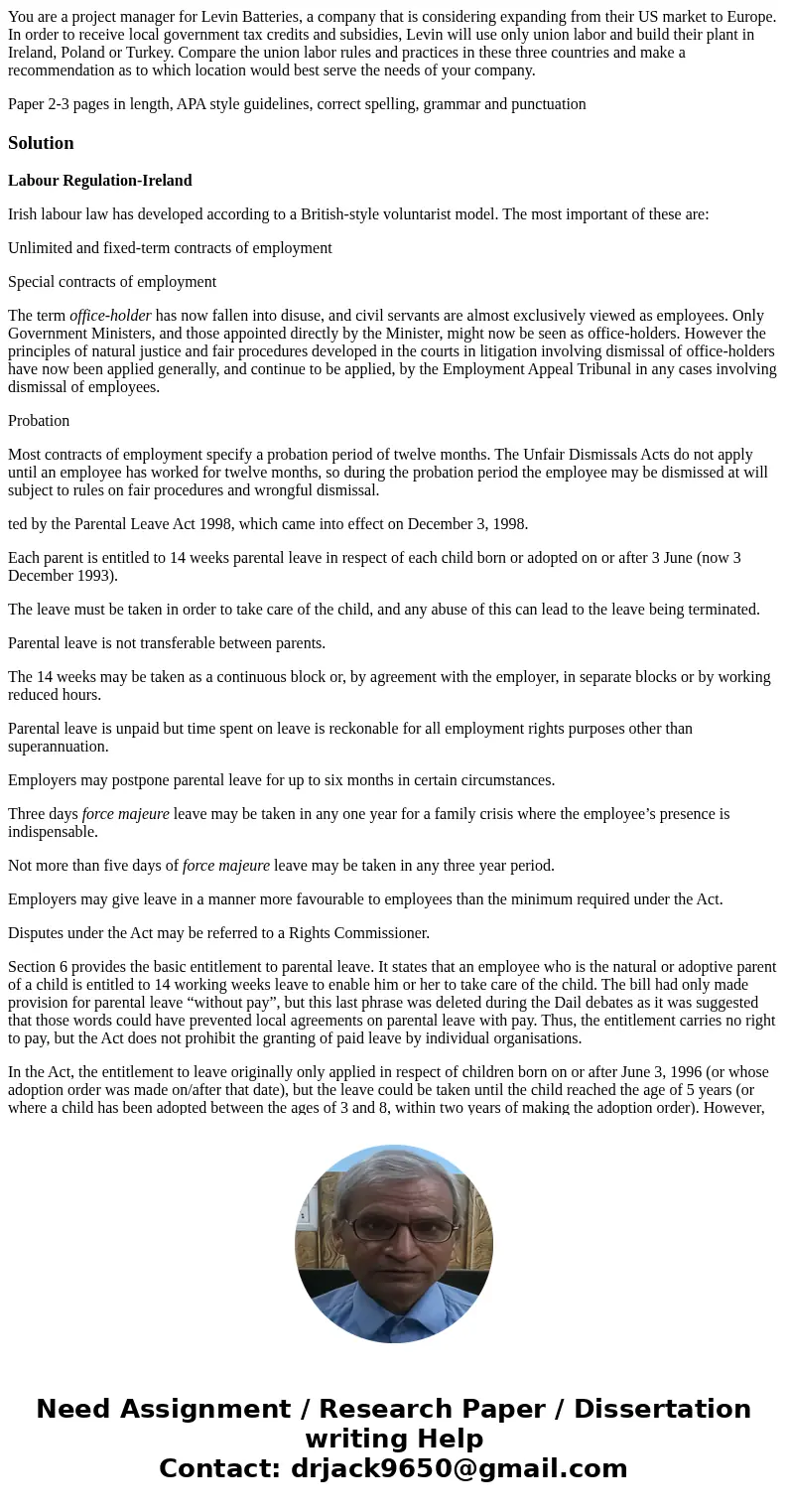
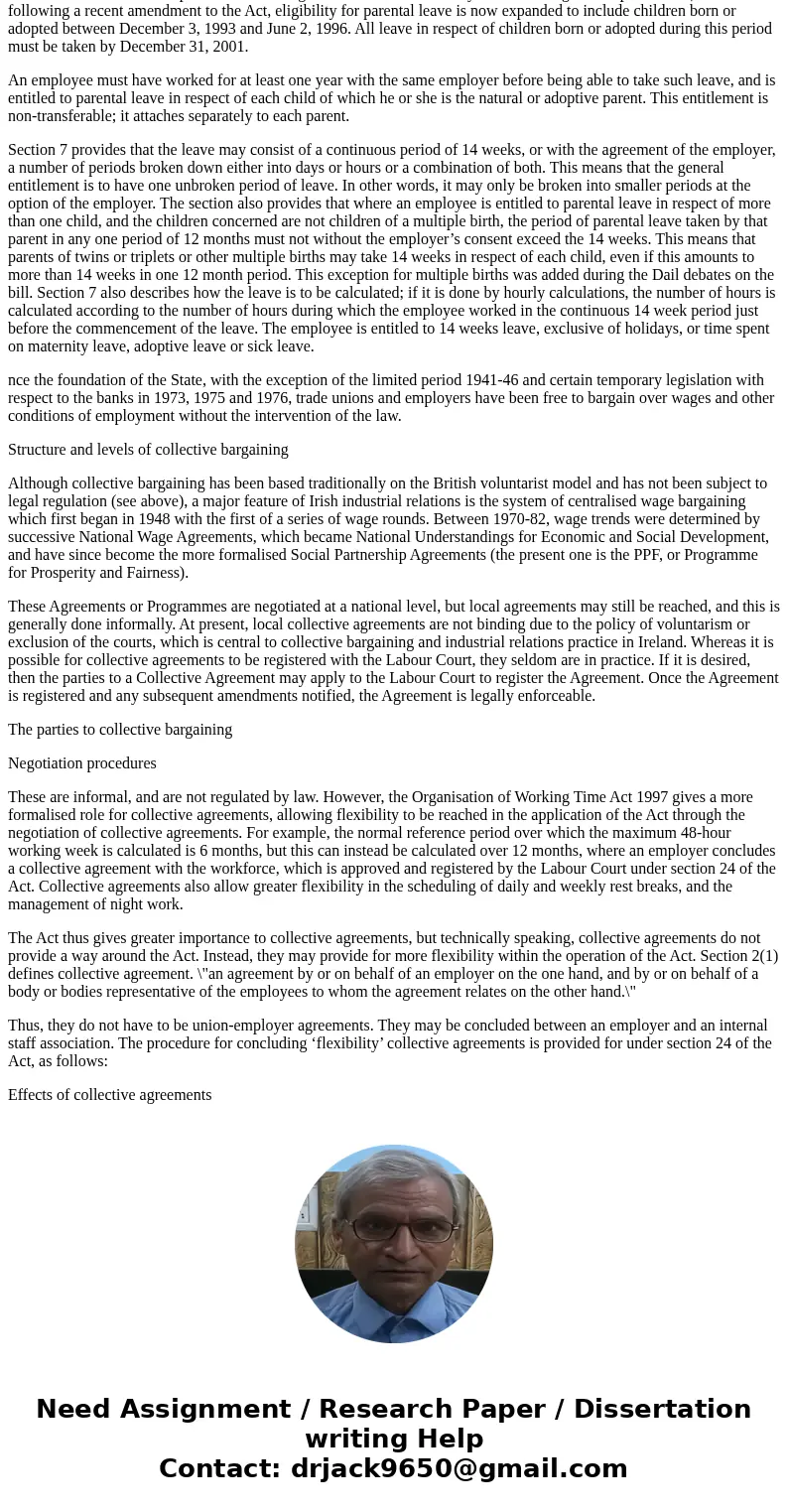
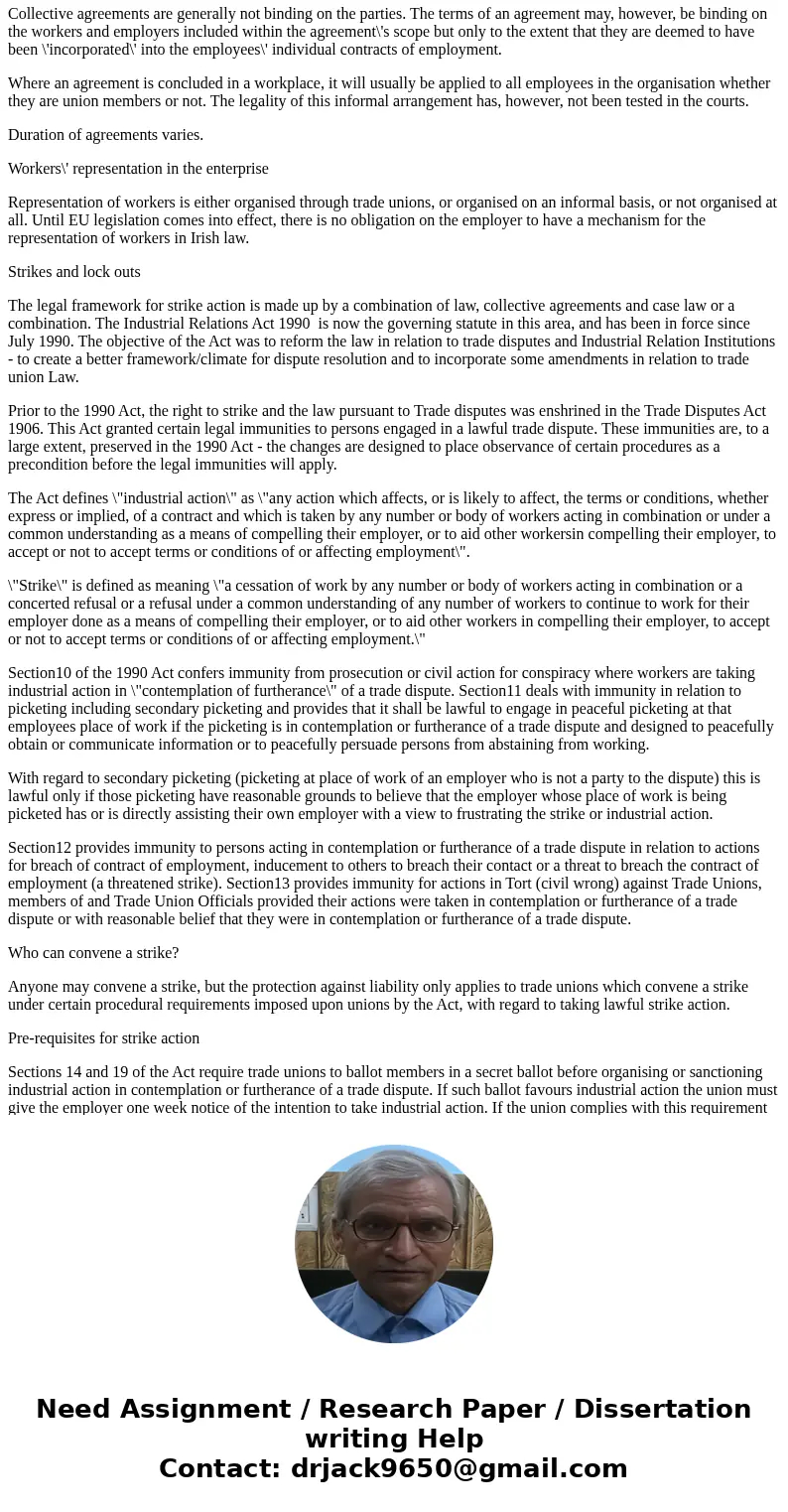
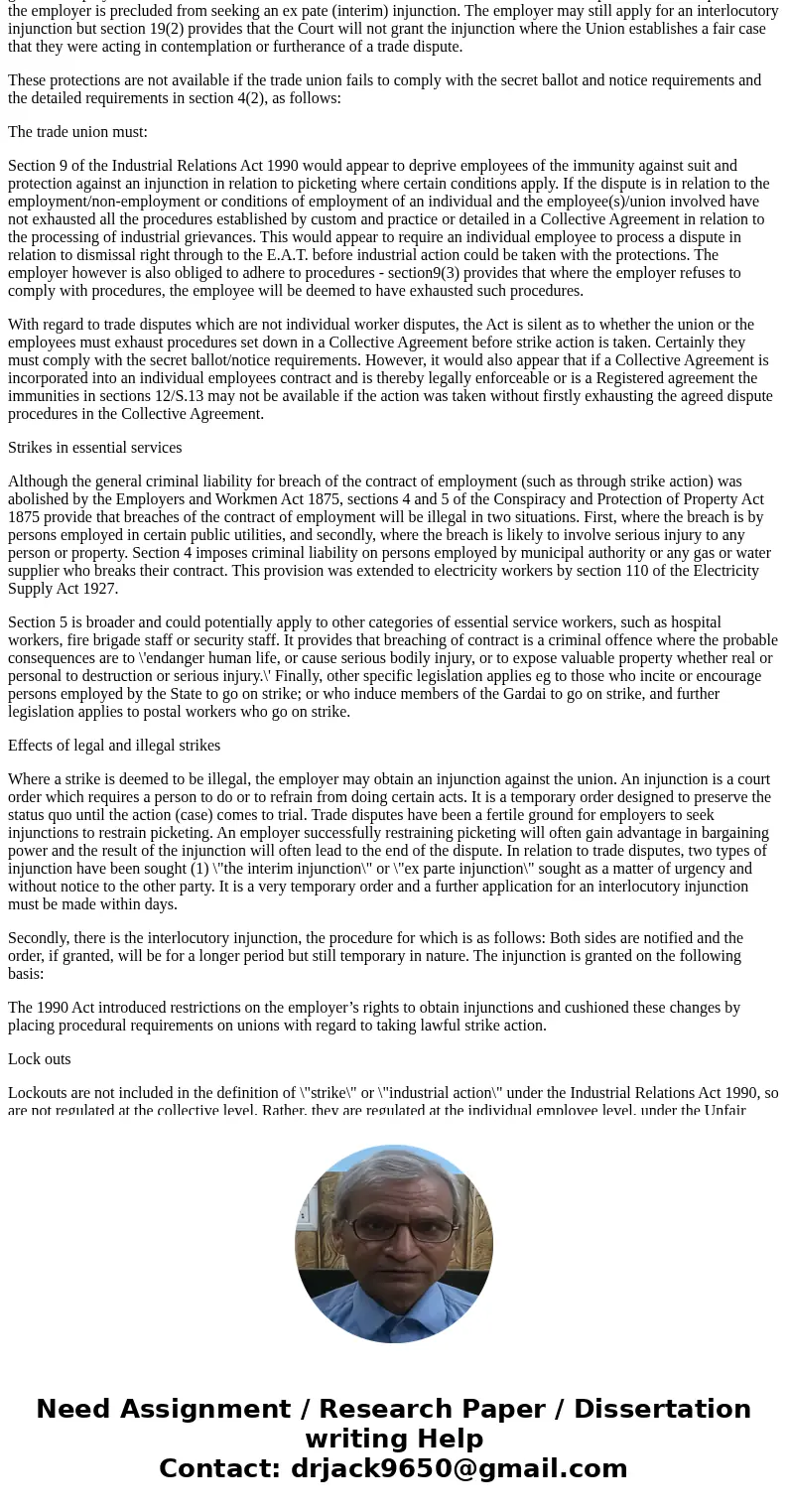
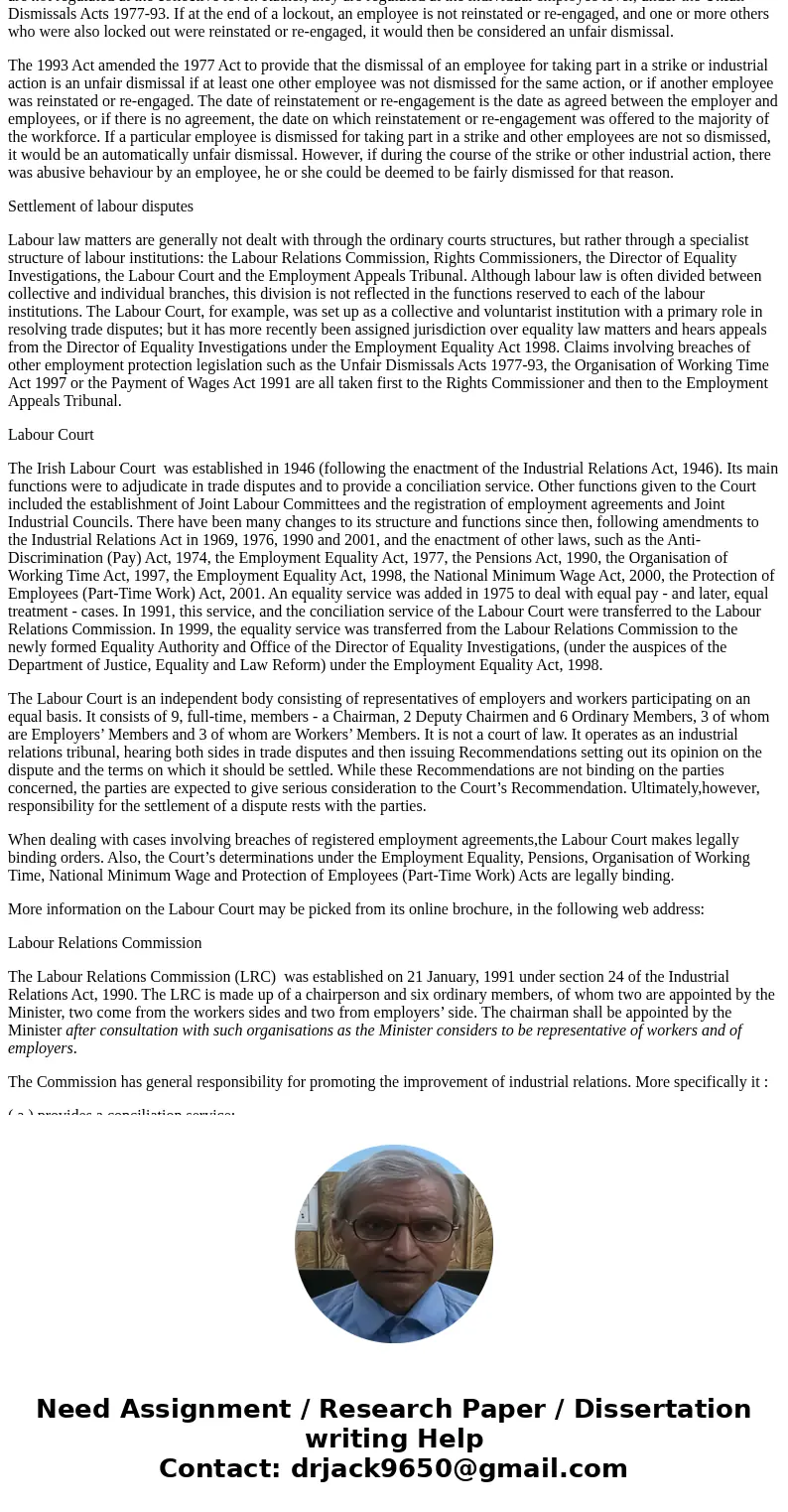
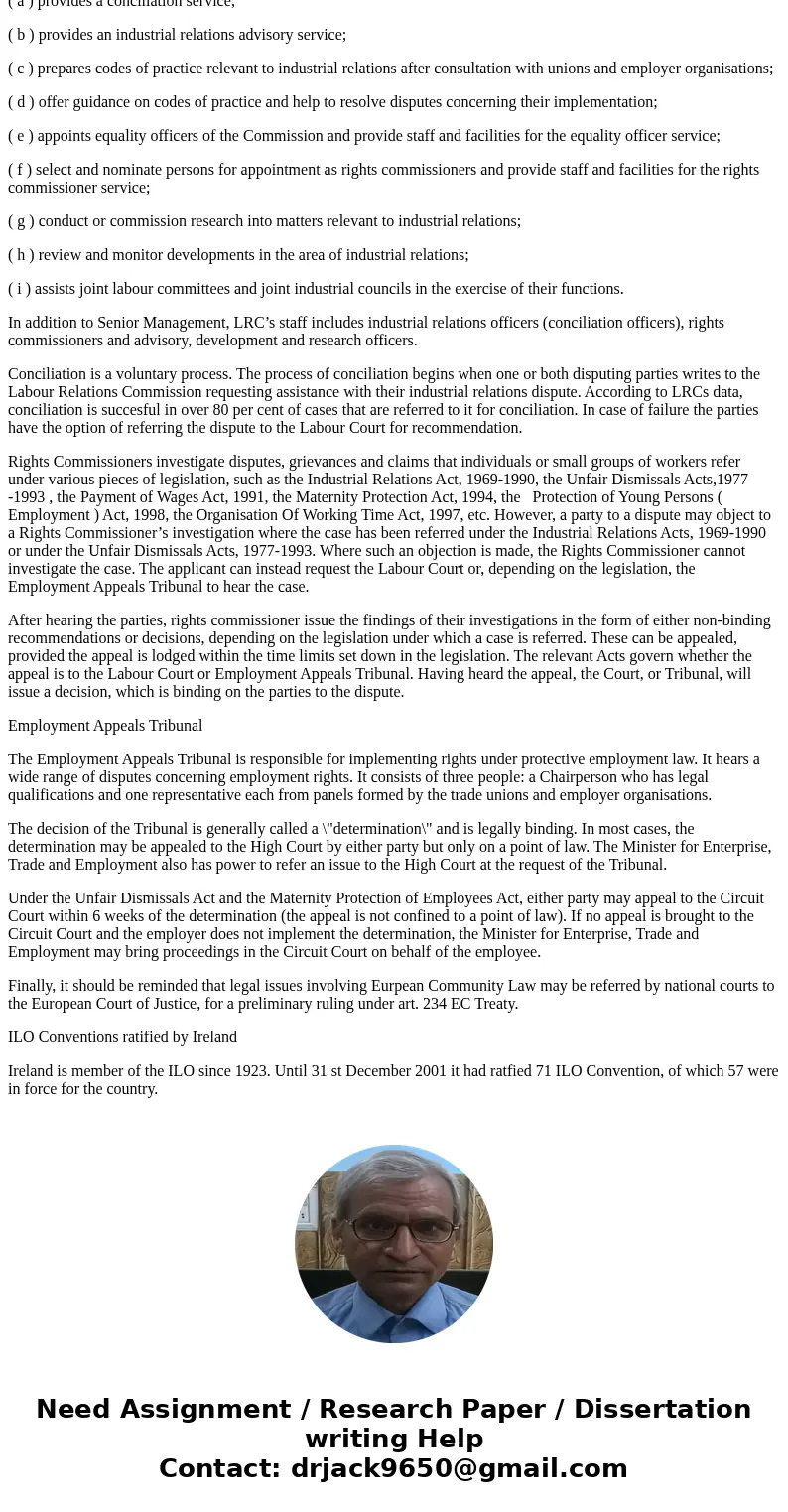
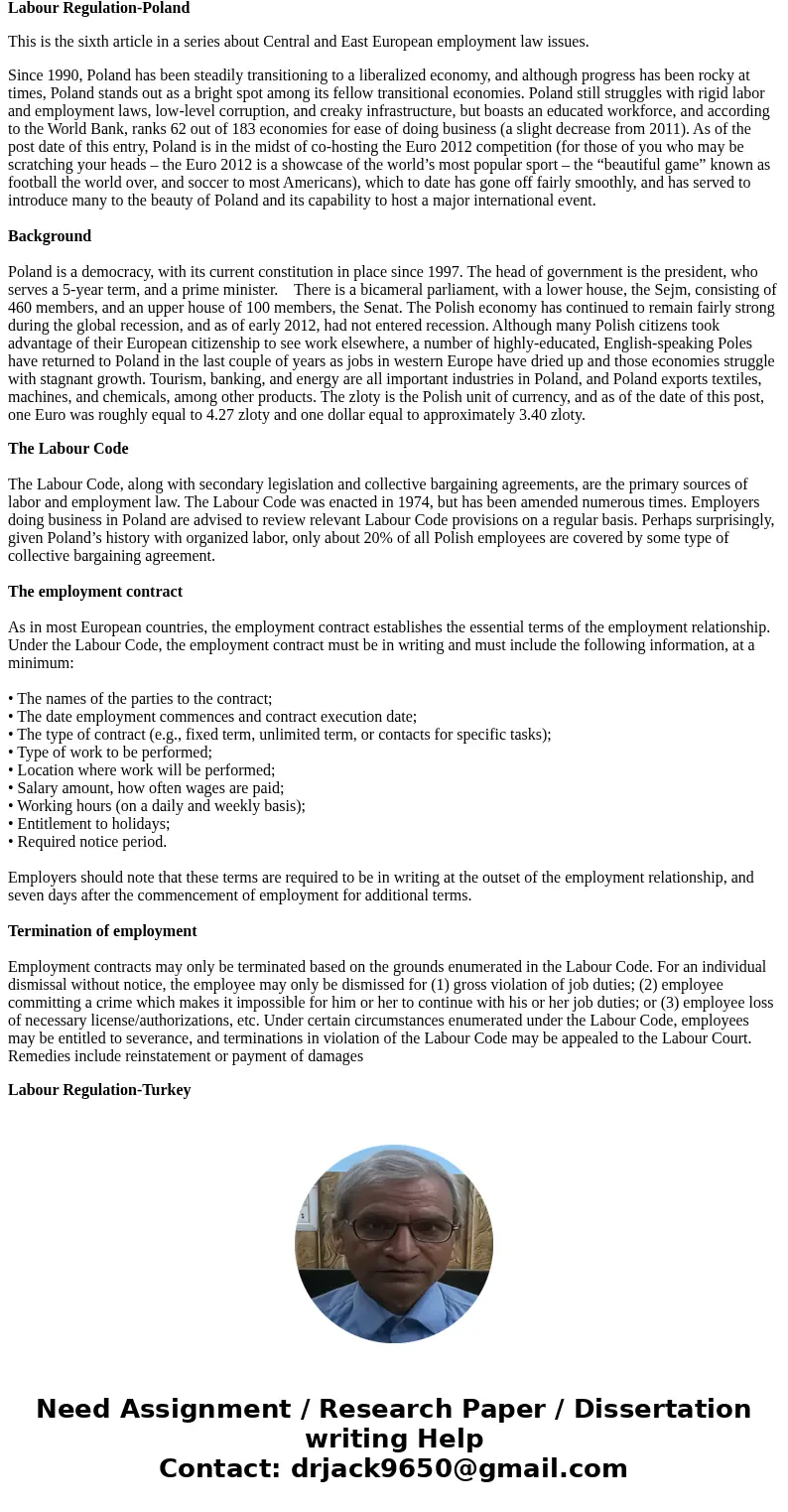
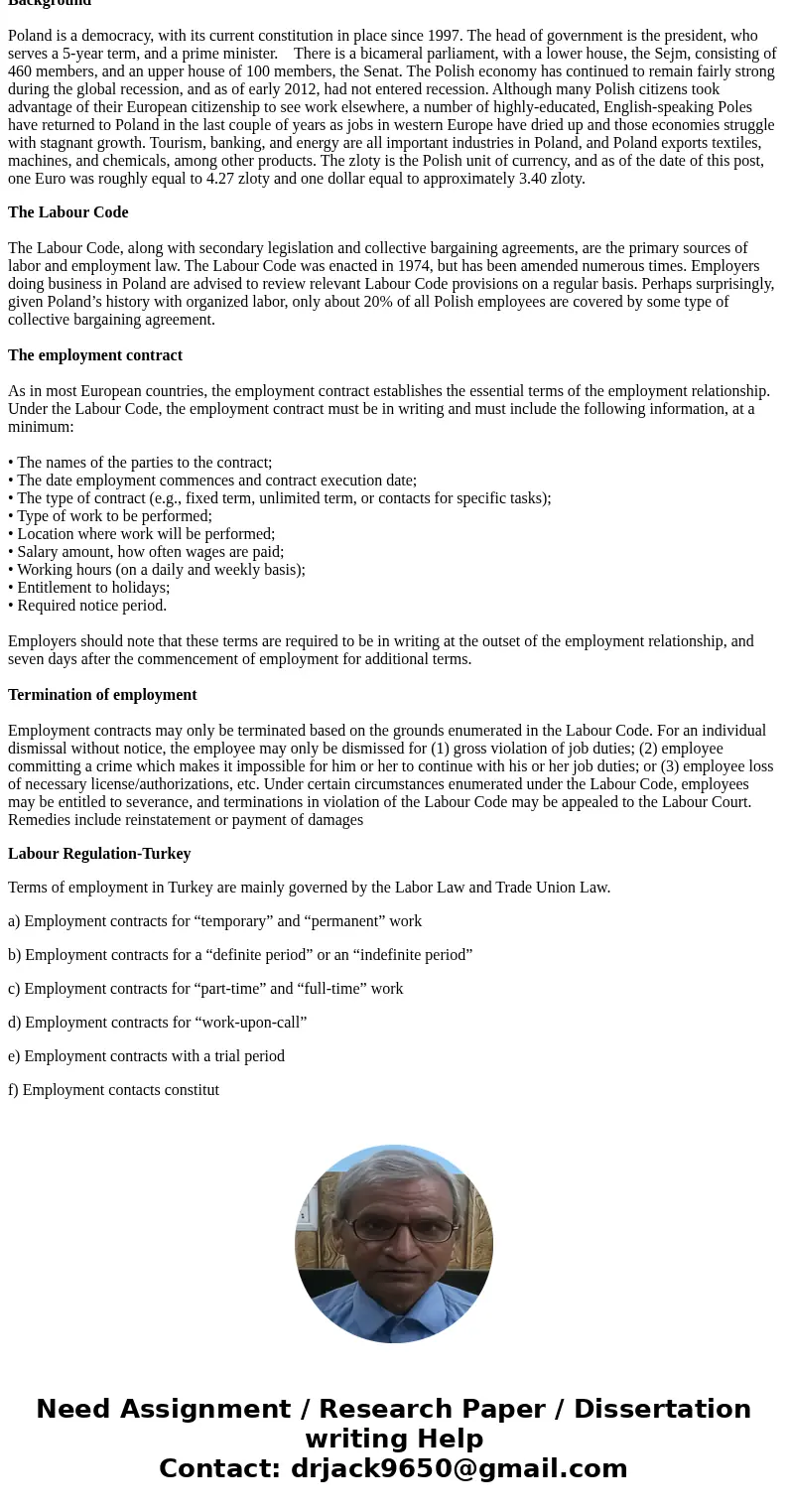
 Homework Sourse
Homework Sourse